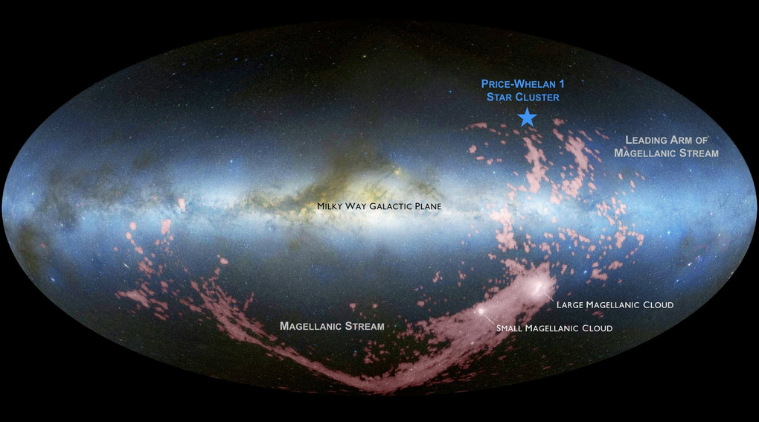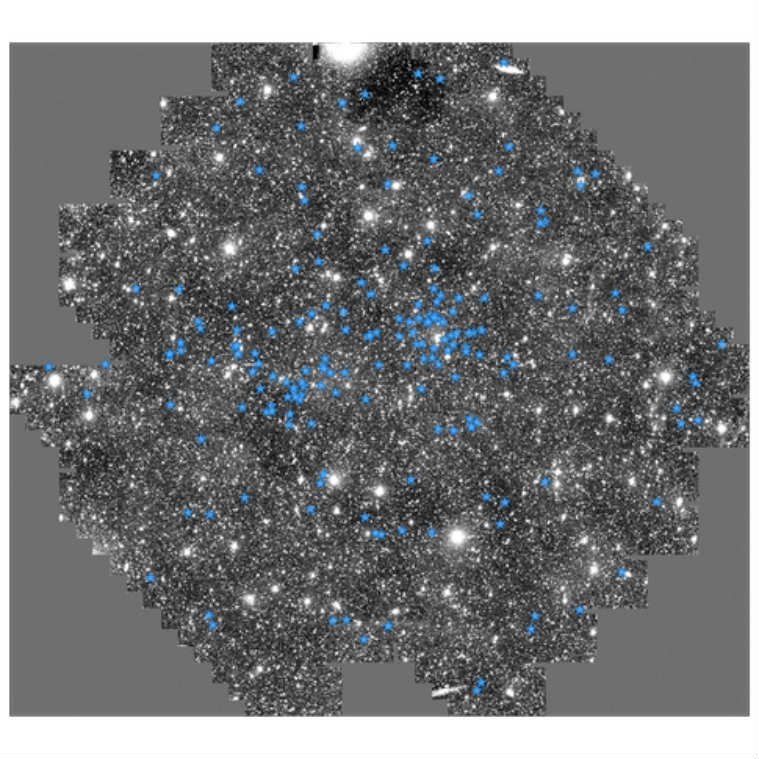Milky Way’s imminent collision with neighbouring galaxy is creating new stars
A newfound cluster of young stars has been found on the periphery of the Milky Way, which is probably formed from material originating from neighbouring dwarf galaxies called the Magellanic Clouds.
 A newfound cluster of young stars (blue star) sits on the periphery of the Milky Way. These stars probably formed from material originating from neighbouring dwarf galaxies called the Magellanic Clouds. (Image: D Nidever; NASA)
A newfound cluster of young stars (blue star) sits on the periphery of the Milky Way. These stars probably formed from material originating from neighbouring dwarf galaxies called the Magellanic Clouds. (Image: D Nidever; NASA)
A research conducted by astrophysicists at Durham University in the UK had suggested that the Milky Way galaxy will dramatically collide with a nearby satellite galaxy– the Large Magellanic Cloud (LMC), which is around 163,000 light-years from us. Even though the collision of the two galaxies is supposed to result in the awakening of a black hole, currently, the interaction between the two is not proving to be destructive at all.
It is believed that the LMC is rich in dark matter, which makes its mass considerably larger. It was predicted that the collision of the two will be catastrophic and end up in a black hole at the heart of Milky Way. However, for now, the interaction of LMC with Milky Way is creating new stars.
NASA adds 11 new astronauts for future Artemis missions to Moon, Mars
Researchers looked for rare blue stars and the clusters of stars that move along with them in our galaxy using data from the Gaia spacecraft. Once they identified and removed known star clusters, they found one remaining cluster on the far edges of the Milky Way, which has not been spotted before.
“It’s really, really far away,” a research fellow at the Flatiron Institute’s Center for Computational Astrophysics in New York City and the primary discoverer, Adrian Price-Whelan, said in a statement. “It’s further than any known young stars in the Milky Way, which are typically in the disk. So right away, I was like, ‘Holy smokes, what is this?’”
 Astronomers have spotted a group of young stars (blue) on the outskirts of the Milky Way. The scientists propose that these stars formed from material from two dwarf galaxies known as the Magellanic Clouds. (Image: A Price-Whelan)
Astronomers have spotted a group of young stars (blue) on the outskirts of the Milky Way. The scientists propose that these stars formed from material from two dwarf galaxies known as the Magellanic Clouds. (Image: A Price-Whelan)
Researchers analysed the elements found in the stars in the cluster to realize that the cluster was likely formed from particles found outside of our galaxy. Since the mystery cluster is located near to a river of gas called the Magellanic Stream that flows from the Large and Small Magellanic Clouds and reaches toward the Milky Way, they believe these other galaxies are the source of the materials which formed the stars.
“This is a puny cluster of stars — less than a few thousand in total — but it has big implications beyond its local area of the Milky Way,” Price-Whelan said. One implication is that the LMC might be closer to the Milky Way than previously believed.
This 17-year-old NASA intern discovered a planet
“If the Magellanic Stream is closer, especially the leading arm closest to our galaxy, then it’s likely to be incorporated into the Milky Way sooner than the current model predicts,” David Nidever, assistant professor of physics at Montana State University in Bozeman, said in the statement. “Eventually, that gas will turn into new stars in the Milky Way’s disk. Right now, our galaxy is using up gas faster than its being replenished. This extra gas coming in will help us replenish that reservoir and make sure that our galaxy continues to thrive and form new stars.”







